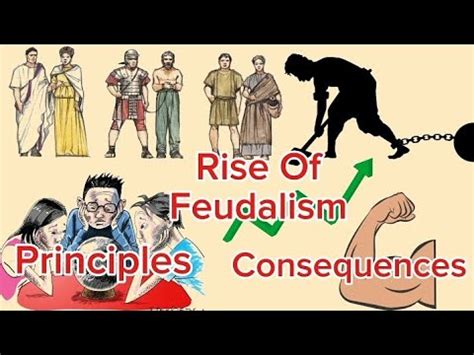Feudalism Explained

Feudalism, a complex and multifaceted system of governance, social hierarchy, and economic organization, dominated medieval Europe from the 9th to the 15th century. At its core, feudalism was a reciprocal relationship between lords and vassals, with the former providing protection and land in exchange for military service, loyalty, and a portion of the vassal's produce. This system, which evolved over time, was characterized by a pyramid-like structure, with the monarch at the apex, followed by the nobility, clergy, and finally, the peasantry.
The origins of feudalism can be traced back to the collapse of the Roman Empire, which led to a power vacuum and the rise of local warlords. These warlords, or lords, would offer protection to smaller landowners, known as vassals, in exchange for their loyalty and military service. Over time, this system became more formalized, with the development of feudal contracts, known as fealty, which outlined the obligations and responsibilities of both parties. The feudal system was also influenced by the Catholic Church, which played a significant role in shaping the moral and ethical framework of medieval society.
Key Points
- Feudalism was a reciprocal relationship between lords and vassals, with the former providing protection and land in exchange for military service and loyalty.
- The feudal system was characterized by a pyramid-like structure, with the monarch at the apex, followed by the nobility, clergy, and finally, the peasantry.
- The origins of feudalism can be traced back to the collapse of the Roman Empire and the rise of local warlords.
- The feudal system was influenced by the Catholic Church, which played a significant role in shaping the moral and ethical framework of medieval society.
- Feudalism had a profound impact on the social, economic, and cultural development of medieval Europe, shaping the course of European history for centuries to come.
The Structure of Feudal Society

Feudal society was divided into three main estates: the nobility, the clergy, and the peasantry. The nobility, which included the monarch, lords, and vassals, held the majority of the land and wielded significant power and influence. The clergy, which included bishops, priests, and monks, played a crucial role in shaping the moral and ethical framework of medieval society, as well as providing education and social services. The peasantry, which made up the majority of the population, worked the land and provided the economic foundation of feudal society.
The feudal system was also characterized by a complex network of relationships and obligations, with each estate having its own set of rights and responsibilities. The nobility, for example, was responsible for providing protection and justice to their vassals, while the vassals were obligated to provide military service and loyalty to their lords. The clergy, on the other hand, was responsible for providing spiritual guidance and education to the population, while the peasantry was responsible for working the land and providing a portion of their produce to their lords.
The Role of the Monarch
The monarch, who sat at the apex of the feudal pyramid, played a crucial role in maintaining the stability and cohesion of feudal society. The monarch was responsible for providing protection and justice to their subjects, as well as maintaining the integrity of the feudal system. The monarch also had the power to grant land and titles to their vassals, which helped to reinforce their loyalty and obligations.
However, the monarch's power was not absolute, and they were often limited by the nobility and the clergy. The nobility, for example, could withhold their military service and loyalty if they felt that the monarch was not fulfilling their obligations, while the clergy could exert significant influence over the monarch through their control of the church and their role as spiritual advisors.
| Feudal Estate | Role and Responsibilities |
|---|---|
| Nobility | Provided protection and justice, held land and wielded significant power and influence |
| Clergy | Provided spiritual guidance and education, played a crucial role in shaping the moral and ethical framework of medieval society |
| Peasantry | Worked the land, provided a portion of their produce to their lords, and formed the economic foundation of feudal society |

The Decline of Feudalism

Feudalism began to decline in the 14th century, due to a combination of factors, including the Black Death, the rise of a money economy, and the growth of centralized states. The Black Death, which devastated Europe in the 14th century, led to a significant decline in the population, which in turn led to a shortage of labor and a rise in wages. This, combined with the rise of a money economy, which allowed for the emergence of a new class of landowners and merchants, eroded the feudal system and created new social and economic structures.
The growth of centralized states, such as France and England, also contributed to the decline of feudalism. These states, which were characterized by a strong monarch and a centralized bureaucracy, were able to exert significant control over their territories and populations, which undermined the power and influence of the nobility and the feudal system.
The Legacy of Feudalism
Despite its decline, feudalism had a profound impact on the social, economic, and cultural development of medieval Europe, shaping the course of European history for centuries to come. The feudal system, for example, helped to establish a hierarchical society, with a strong emphasis on loyalty, duty, and obligation. It also helped to create a sense of community and shared identity, with the nobility and clergy playing a crucial role in shaping the moral and ethical framework of medieval society.
Furthermore, the feudal system helped to lay the foundations for the emergence of modern nation-states, with the growth of centralized states and the decline of feudalism paving the way for the development of modern political systems and institutions. The legacy of feudalism can also be seen in the modern concept of property rights, with the idea of private property and the right to own and dispose of land and goods emerging during the feudal period.
What were the main characteristics of the feudal system?
+The feudal system was characterized by a reciprocal relationship between lords and vassals, with the former providing protection and land in exchange for military service and loyalty. It was also marked by a hierarchical society, with a strong emphasis on loyalty, duty, and obligation.
How did the feudal system contribute to the emergence of modern nation-states?
+The feudal system helped to lay the foundations for the emergence of modern nation-states, with the growth of centralized states and the decline of feudalism paving the way for the development of modern political systems and institutions.
What was the role of the clergy in the feudal system?
+The clergy played a crucial role in shaping the moral and ethical framework of medieval society, as well as providing education and social services. They also exerted significant influence over the monarch and the nobility, helping to maintain the stability and cohesion of feudal society.



